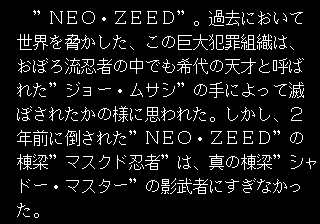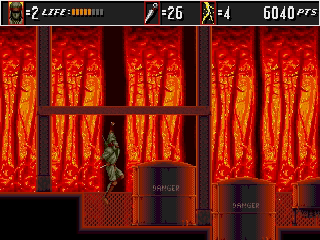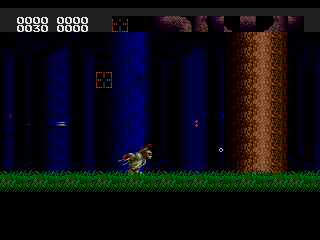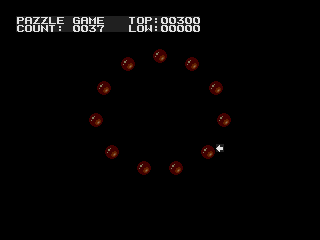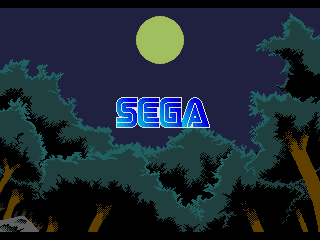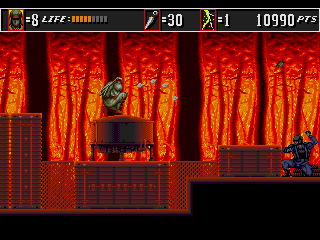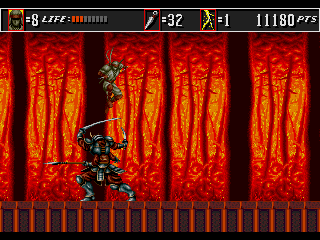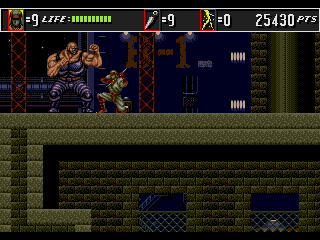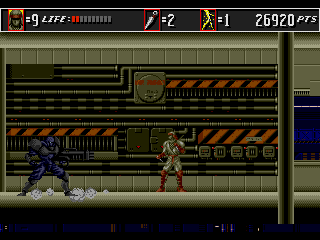Proto:Shinobi III: Return of the Ninja Master/November 1992 Prototype
This is a sub-page of Proto:Shinobi III: Return of the Ninja Master.
| This page sucks. If you could make it suck less, that would be awesome. Specifically: This is so bare-bones and vague that it's painful to read. |
(Note: The Super Shinobi II is the Japanese name of Shinobi III, so it will be called by that name here.)
A VERY early prototype of The Super Shinobi II, dated November 1992 in the header. At this point, it's so early in development that it's less a game and more a mishmash of assets, but it contains a lot of concepts, enemies, and artwork that aren't in any other available version of the game.
| To do: LOTS of things left, including:
|
| Download The Super Shinobi II (1992 Proto)
File: The_Super_Shinobi_II_(1992_Prototype).zip (522 KB) (info)
|
Contents
General Differences
Story
Unlike the final game, the prototype has a story synopsis that plays before the demo.
At one point, Neo Zeed would have been renamed to "Neo Ghost" following the events of the previous game. The final game just keeps the "Neo Zeed" name, both in-game and in the manual.
Gameplay
- Musashi's physics are overall somewhat floatier.
- Musashi can't walljump yet.
- Musashi can do a backflip move, which appears to have been cut from the final.
- You don't bounce off enemies when air-kicking them.
- The dash attack move doesn't give invincibility while attacking.
- Shurikens have a smaller hitbox, making it somewhat more difficult to hit a given target.
- You collide with all ceilings, even the ones you can go through. You must first grab the ceiling, then jump up to pass through.
- Speaking of grabbing ceilings, it's pretty finicky here. Musashi is prone to sometimes jittering around when he grabs one. For example, dropping down while holding Up to grab it again will just cause him to jitter in place.
- Holding C while attached to a ceiling plays a swinging animation, which was also removed from the final. Presumably, Musashi would pull himself up after holding C for long enough, but he just blasts off into the sky instead.
- When you kill an enemy, it flies back, but doesn't lose its hitbox, meaning you can still get hurt by touching it. You can also hit the corpse again to send it flying back further.
- There are no minibosses; you're just taken to the next stage abruptly.
- All of the bosses don't work. They have no collision, and just cycle though their animations. Walking to the right clears their stages.
- Pressing Up or Down pans the camera in those directions instantly, rather than having to hold them for several seconds like the final. It also doesn't pan back when you let go.
Audio
The music in this build sounds mostly complete. Most of the changes made to them for the final are minor.
| Name (Proto) | Name (Final) | Proto | Final | Notes |
|---|---|---|---|---|
| He Runs | He Runs | Used in stages 1-1, 1-2, 4-1, 4-2, 4-3, 5-1, 5-2, 6-1, 7-1, 7-2, 7-3, 8-1, and 8-2. The lead is quieter, and the drum patterns differ all around, making the song feel less full. The PSG is also missing at 1:03-1:31, and the following solo goes on for much longer, as well as the backing chords being different in the solo. | ||
| Ninja Soul | Ninja Soul | Used in stages 1-3, 1-4, 2-2, 2-3, 2-4, 3-4, 4-4, 5-3, 5-4, 6-2, 8-3, and 8-4. Instrumentation is quite different overall. A different bass sound, a different lead instrument at 0:02-0:10, different drum patterns from 0:41 onwards, and a completely different instrument for the following solo. | ||
| Ninja Soul | Ninja Soul | Unused track. Accessible by using Game Genie code MT5A-NW98 then playing Ninja Soul music in the Options menu. | ||
| Boss!Boss! | Shadows | Used for all boss stages. Very different instrumentation, making the proto sound more tense than the final. 0:21 onwards has been completely changed. | ||
| Hassou!!! | Hassou! | Goes unused in gameplay. Sounds mostly the same, apart from a different-sounding intro, bass sound, and snare drum sample. 0:42 onwards was completely scrapped from the final. | ||
| Inner Darkside | Inner Darkside | Used in stages 3-1 and 3-2, as well as the bonus game. Sounds nearly identical to the final, but the proto is completely missing the hi-hats. The backing channel at 1:30-1:56 is also panned to the right in the proto, while it's in the center in the final. | ||
| ??? | N/A | N/A | An oddly upbeat jingle which resembles nothing in the final. It also goes unused in gameplay. Weirdly, this is the only track which can't be played through the sound test. It's speculated that this would have been used for the intro sequence, as it syncs up quite well with it (though the video showing it off has been deleted). | |
| Shinobi Walk | Shinobi Walk | Used in stage 2-1. Much different bass sound and drum patterns overall. PSG is also much more pronounced as well, particularly at 0:43-1:21 where it isn't used at all in the final. | ||
| Rush © Beat Me | Rush and Beat | Goes unused in gameplay. PSG is missing at 0:08-0:36, and the following solo at 0:37-0:50 has completely different instrumentation. | ||
| Map Da! | Storm Wind | Used for the round start screen. Sounds nearly identical to the final, apart from different drum samples. | ||
| Round Clear | Round Clear | Used for the round clear screen. Sounds nearly identical to the final, apart from different drum samples. | ||
| Ninja Lulubay | Wabi | Goes unused in gameplay. Sounds practically identical to the final. | ||
| Sakura | Sabi | Goes unused in gameplay. Sounds practically identical to the final. | ||
| Yayoi | N/A | N/A | Another unfitting tune which resembles nothing in the final. It also goes unused in this build. | |
| Ju Goya | Getufu | Used in stages 7-4, 7-5, and 7-6. The lead instrument is slightly different. | ||
| The End | Sakura | Used for the ending sequence. Very different instrumentation in the intro, making the final sound much softer. The lead at 0:20-0:34 was changed from a trumpet to a flute. The proto has a completely new section at 0:47-1:40, extending the song quite a bit over the final. Instrumentation for the outro is also different, particularly with the final adding a tuba to end the track. |
Debug Menu
| To do: Controls for the debug menu |
A debug menu is accessible by pressing B + C then A. It contains a graphics editor, a memory editor, and a level editor. Though the graphics editor can be found in all other versions of the game, the memory and level editor are exclusive to this prototype.
Hidden Puzzle Game
| To do: How do you access it, and how does it play? |
This is a pseudo-hidden puzzle game, incorrectly romanized as "pazzle game".
Introduction
This early version of the first scene shows a simpler and less detailed background. The trees are missing a lot of shading, while the moon is just a yellow circle. In the final version this scene contains more detail and a more advanced style.
The ninja clearly seems to be a more realistic representation of a middle-aged man, while using grim colors for his design. This design was replaced by a more heroic and smoother looking ninja in the final release.
Levels
Level 1
The early prototype contains a much bigger and harder to defeat basic enemy ninja. Upon being hit, the enemy ninja will be knocked backwards and recover. When defeated, it will take on a ninja finger signal pose, then teleport and drop down near the player to attack again.
Level 2
An early level featuring an impressive background showing a burning forest. The player seems to be walking outside of an enemy base with what appears to be storage barrels spread throughout the level. This could mean that the player might be walking on the roof of a base near a burning forest.
The bosses at the end of the levels have not been programmed yet, so instead they stand in place and cycle through all of their sprites. They also don't have any collision detection, so you can complete the level simply by walking through them and to the right.
Level 3
A rather awkward and very buggy level somewhere in a city. The player can switch from being behind the fence and walls by double jumping, similar to the gimmick in stage 3-1 of Revenge of Shinobi. However, it's definitely not complete, as you don't just jump over the fence, you can go behind the walls as well...
Level 4
A sabertooth tiger attacking the player in a tech base. The tech base itself is just a straight line. The level design was not finished or interesting (yet). It does show how they re-used these tiles in the final game.
These enemies dash around at high speed while remaining on the floor. They shoot quite a few rockets in a straight line towards the player after every dash.

